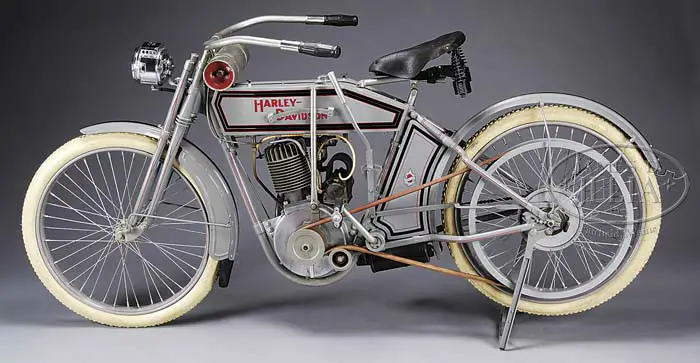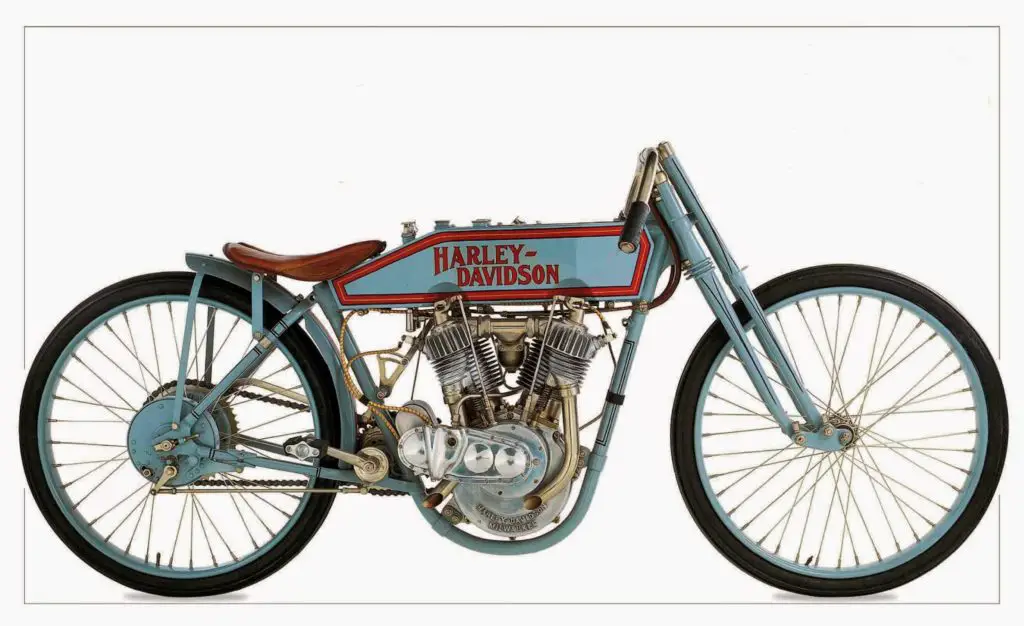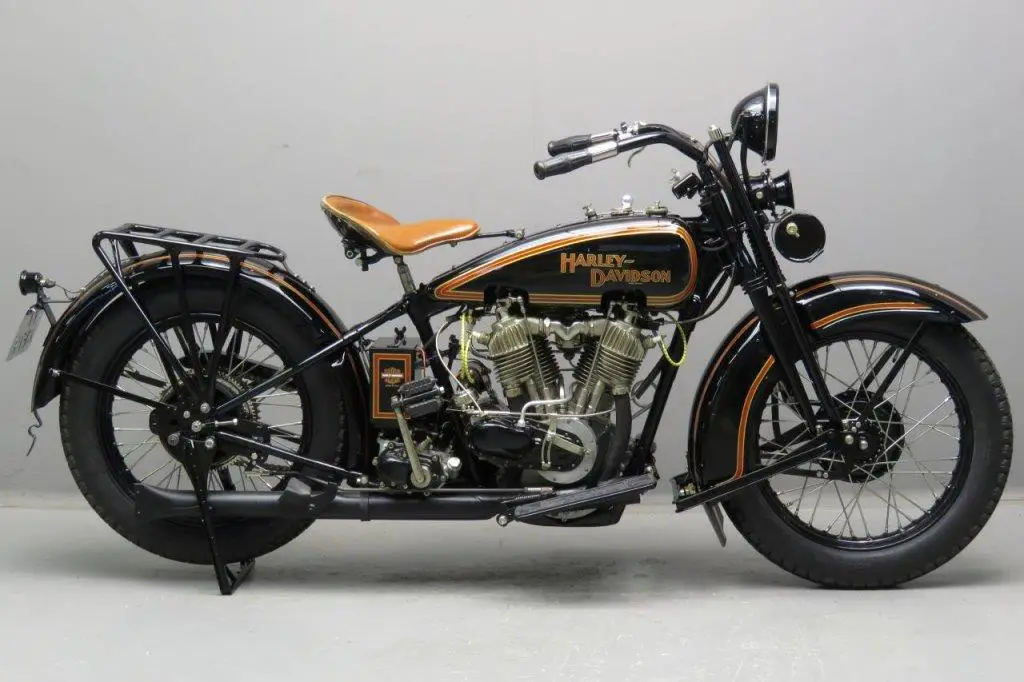The Harley Davidson motorcycle has been an American icon for over a century. The Harley has become a symbol of freedom and rebellion known for its power, durability, and style.
This blog post will explore the early years of the Harley Davidson bike, from 1903 to 1929. We will look at some of the most popular models from that time period and see how Harley Davidson evolved as a company to create some of the most iconic motorcycles ever made.
Quick Article Navigation
The Evolution of Harley-Davidson
Harley Davidson was founded in 1903 by William S. Harley and Arthur Davidson. The first prototype of their now-famous motorcycle was created that same year. It wasn’t until 1905 that the first production model, known as the Model No.
A commitment to quality and innovation marked the early years of Harley Davidson.
In 1912, they introduced the Silent Gray Fellow, one of the first motorcycles equipped with an electric starter. This made it much easier to start the engine and helped to make Harley Davidson bikes more popular.
1915 saw the introduction of two new models: the KT Board Racer and the KR Fast Roadster. The KT was a racing bike that could reach speeds of up to 60 miles per hour, while the KR was a more street-friendly version that was perfect for cruising around town.
One of the most important aspects of Harley Davidson’s success has been its engines. The early years saw a gradual evolution from the first prototypes to the last of the inlet-over-exhaust valve machines of 1929.
The 45° F-Head V-Twin was introduced in 1915 and quickly became one of the most popular engines used in Harley Davidson motorcycles. This engine would be used for many years to come and is still considered one of the best motorcycle engines ever made.
In 1928, the company introduced the JD, which was one of the first Harley Davidson bikes to feature a side-valve engine. This new engine design would become the standard for Harley Davidson motorcycles for many years to come.
Harley Davidson has come a long way since its humble beginnings in 1903. From its early days as a pioneer in the motorcycle industry to its current status as an American icon, Harley Davidson has always been a company committed to quality and innovation. Thanks for taking a look at the early years of this great American company!
The Early Harley Davidson Bikes
Now let’s take a look at some of the most popular Harley Davidson bikes from the early years 1903-1929.
1905 Harley-Davidson Model No.1

1905 Model No.1 was the first Harley-Davidson motorcycle. It had a bigger engine than most of its contemporary manufacturers but still used pedal power on hills. The bottom frame tube was curved under the crankcases to allow the engine to be mounted lower in the frame, resulting in superior handling.
The battery ignition system, crude carburetor, belt drive, and other unrefined elements ensured that the early motorcycle wasn’t really a viable means of transportation. Still, at least the Model No.1 was a cut above the average.
1905 Model No.1 was a milestone for Harley-Davidson, as it was their first motorcycle. Although it wasn’t perfect, it was a big step in the right direction and laid the foundation for future success.
Specifications
| Model | 1905 Model No.1 |
| ENGINE | Inlet-over-exhaust single |
| CAPACITY | 24.74cu. in. (405.41cc) |
| POWER OUTPUT | Unknown |
| TRANSMISSION | Single-speed, belt drive |
| FRAME | Tubular loop |
| SUSPENSION | None |
| WEIGHT | 1851b (84kg) |
| TOP SPEED | 40mph (64km/h) (est.) |
1912 Harley-Davidson Silent Gray Fellow

1912 was a big year for Harley-Davidson. Not only did they release the X-8 single, but they also established themselves as a major motorcycle manufacturer.
The X-8 single was a more refined model of transportation with sprung forks and magneto ignition. The original 1903 Harley had a 24.74cu. in (405cc) engine, rising to 26.8cu. in. (440cc) in 1906, and 30cu. in. (494cc) in 1909. In 1913 it gained a further 5cu. in. (82cc).
The Harley single became a valued and dependable machine, earning it the nickname “Silent Gray Fellow.” 1912 was definitely a turning point for Harley-Davidson, and the Silent Gray Fellow was at the forefront of it all.
Specifications
| Model | 1912 Silent Gray Fellow |
| ENGINE | Inlet-over-exhaust, single-cylinder |
| CAPACITY | 30cu. in. (494cc) |
| POWER OUTPUT | 6.5bhp @ 2,700rpm |
| TRANSMISSION | Single-speed, belt drive |
| FRAME | Tubular loop |
| SUSPENSION | Leading-link forks, rigid rear |
| WEIGHT | 1951b (89kg) |
| TOP SPEED | 45mph (72km/h) |
1915 Harley-Davidson KT Board Racer

Harley-Davidson’s entry into team racing in 1914 was a savvy move that paid off almost immediately. The board track racing craze was sweeping the nation, and Harley was able to capitalize on the popularity by entering its own race team.
The 1915 KT Board Racer was one of the first bikes ridden by the Harley race team and performed admirably. In September 1915, an F-head Harley set a 100-mile (161-km) record of 89.11mph (143.46km/h) on a board track in Chicago. This success laid the groundwork for launching the famous eight-valve racer (see pp.46–47) a year later.
Thanks to its racing success, Harley-Davidson was able to build a reputation as one of the world’s most innovative and successful motorcycle manufacturers. It’s all thanks to their participation in team racing back in 1914.
There was no gearbox and usually no brakes, though this bike is fitted with a rear drum. Their appearance belied their astonishing strength and performance – these bikes could be run flat-out for considerable distances, with 100-mile (161-km) races not uncommon on the banked wooden tracks. These lightweight machines were powerful and handled well, making them perfect for board track racing.
The 1915 KT Board Racer was one of the most successful board track racers of its day, winning numerous races and setting several records. Despite their popularity, board track racing fell out of favor in the 1920s, as safer and more forgiving concrete tracks began to replace the dangerous wooden ones.
Today, however, board trackers are enjoying a resurgence in popularity, as riders are drawn to their unique style and performance.
Specifications
| Model | 1915 KT Board Racer |
| ENGINE | Inlet-over-exhaust, V-twin |
| CAPACITY | 61cu. in. (1000cc) |
| POWER OUTPUT | 15bhp |
| TRANSMISSION | Three-speed, chain drive |
| FRAME | Tubular loop |
| SUSPENSION | Leading-link front forks, rigid rear |
| WEIGHT | 325lb (147kg) |
| TOP SPEED | 80mph (130km/h) |
1915 Harley-Davidson KR Fast Roadster

The 1915 KR Fast Roadster was a race bike developed by Harley-Davidson. It was based on the board track racer but fitted with mudguards, a chainguard, and conventional handlebars. One hundred were built, and it is now a scarce model.
The Fast Roadster was built for amateur racers at a time when Harley-Davidson’s factory race team was starting to taste success; the K-series won a number of 100- and 300-mile (161- and 483-km) races for Harley in 1915.
This bike was ahead of its time and influenced other manufacturers to create similar bikes. The Fast Roadster is a collector’s item now and is highly sought after by motorcycle enthusiasts.
Specifications
| Model | 1915 KR Fast Roadster |
| ENGINE | Inlet-over-exhaust, V-twin |
| CAPACITY | 61cu. in. (1000cc) |
| POWER OUTPUT | 15bhp |
| TRANSMISSION | Single-speed competition gearbox, chain drive |
| FRAME | Tubular loop |
| SUSPENSION | Leading-link front forks, rigid rear |
| WEIGHT | 325lb (147kg) |
| TOP SPEED | 80mph (130km/h) |
1915 Harley-Davidson Model F

1915 was a significant year in the development of Harley-Davidson’s road bikes. The introduction of a number of innovative new features meant that the motorcycle came of age as a practical machine.
As far as Harley was concerned, there were three main innovations: a three-speed gearbox, a mechanical oil pump, and electrical lighting.
The gearbox made the bikes faster, gave them better hillclimbing ability, and improved low-speed running. The motor-driven oil pump guaranteed better lubrication and improved engine life.
Electrical lighting meant that trips at night could now be undertaken at times other than when the moon was full. The 1915 Model F was the first bike to boast all three of these features.
It was faster, more comfortable, and more reliable than any other bike on the market and quickly became the standard by which all other motorcycles were judged.
For 1915 Harley-Davidson listed five V-twin motorcycles with a combination of single three-speed transmission and with or without an electrical system. The Model F had three gears but no electric lights and sold for $275. A V-twin commercial tricycle was also available in the 1915 range, which had a box and two front wheels instead of conventional motorcycle forks.
1915 Model Fs were the police officers’ friends. They quickly saw the benefit of using high-performance motorcycles to chase errant motorists in low-performance automobiles, and Harley V-twins became the models of choice.
Their 60mph (97km/h) top speed is among the fastest bikes around. This department is mounted on 1915 Model Js, which was the model from the Model F in that it had electric lighting.
The 1915 Model F was an excellent choice for police departments because it was fast, had electric lighting, and was durable. The 1915 Model F is a perfect example of how choosing the right tool for the job can make a big difference.
Specifications
| Model | 1915 Model F |
| ENGINE | Inlet-over-exhaust, V-twin |
| CAPACITY | 61cu. in. (1000cc) |
| POWER OUTPUT | 11bhp |
| TRANSMISSION | Three-speed, chain drive |
| FRAME | Tubular loop |
| SUSPENSION | Leading-link front forks, rigid rear |
| WEIGHT | 325lb (147.5kg) |
| TOP SPEED | 60mph (97km/h) |
1928 Harley-Davidson JD

1928 JD Model Harley-Davidson was one of the most powerful machines on the road in the 1920s. It had a big F-head twin engine that could outrun almost any other vehicle.
The 1928 JD was so popular with police departments that many riders considered it a step backward when Harley replaced the F-head twins with side-valve machines in 1930.
At first, the new side valves were slower and no more reliable than the trusty F-head. However, over time, the side-valve engines proved more durable and easier to maintain, making them the preferred choice for most riders.
From 1923 until 1930, the single camshaft JD model was a high-performance Harley that outsold every other Harley during that period.
This was partly due to its popularity with police departments. Sporting riders who wanted even more performance could opt for the two-cam JDH model with its race-derived engine.
The 1928 Harley-Davidson JD was one of the most popular motorcycles of its time. Part of its appeal was its versatility – it could be used for both leisure and work purposes. Sporting riders who wanted even more performance could opt for the two-cam JDH model with its race-derived engine.
This made the JD a favorite with police departments, as it could keep up with high-speed chases. The JD also became known for its durability, as it could withstand the rigors of long-distance touring. As a result of all these factors, the 1928 Harley-Davidson JD became one of the most iconic motorcycles of the 1920s.
Specifications
| Model | 1928 JD |
| ENGINE | Inlet-over-exhaust, V-twin |
| CAPACITY | 74cu. in. (1213cc) |
| POWER OUTPUT | 18bhp |
| TRANSMISSION | Three-speed, hand shift |
| FRAME | Tubular cradle |
| SUSPENSION | Leading-link front forks |
| WEIGHT | 365lb (166kg) |
| TOP SPEED | 75mph (121km/h) |
Keep reading the next chapter about early Harley Davidson innovations in 1918–1942.
